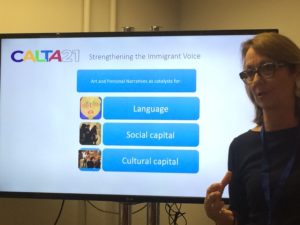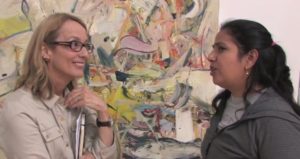JME in Action: How can museums become a home for newcomers?

Immigration is at the core of my personal and professional life. The journey that started when I left Uruguay as a young adult and moved first to Argentina and later in life to the USA is the lens through which I see the world and my place in it. After my last move to New York and with a family in tow, art museums became the place where we went to try to distill what America meant to us. They became a safe and inspiring space for my family. We engaged in aesthetic encounters that nurtured our conversations, but they also provided me with a window into the complexity and tensions of what American society values, respects and promotes. As a museum lover, I have observed the minds behind administration, curatorial, education, public program choices. Museum cafes, shops, information booths, and the people who give life to museums have shaped my view of museums in the USA. My commitment to working with immigrant communities and my belief in the role that newcomers can play in cultural institutions led me to conceive Cultures and Literacies through Art for the 21st Century (CALTA 21). As a cultural agent, I feel that by having a voice and a space in the museum field, I also have a responsibility to historically marginalized communities that have not been part of the fabric of the museums, not by their choice, but by someone else’s decision that their story or voice didn’t belong in the museum.
Absences and presences: a value system where immigrants are an asset and not a threat

Museums are dynamic places where cultures intersect, where the absences and presences, bridges and boundaries become explicit and visible. My view of museums is a privileged one, since I consider that having multiple points of view to an issue is an asset. I have the insider art- and history-educated cultural worker lens and the outsider immigrant, foreign-born and raised, language learner lens. My Latina identity is at the crossroads, this became evident when I moved to this country and was made aware when being referred to as “you Latinos” made me part of the Latinx community as well as a differentiated group within larger American society, making me an outsider and insider simultaneously.
Museums are spaces dedicated to culture, and the cultures represented mirror a society’s values; therefore museums are about value systems. My professional concern is which values are represented and how those values that are supported and disseminated by museums reflect the 21st century pluralistic society. Our choices and actions as museum professionals matter. In a democratic society there has to be space for the representation of the communities’ values and museums have the responsibility to represent them and engage with all community members, including the last ones to settle in their adopted home.
Principles that guide my work as a museum educator with immigrant communities

My work with museums and immigrant communities has led me to distill a number of guiding principles that ensure that our work supports principles of equity. As museum educators, and in my case specifically as an art museum educator, we are at the intersection of the artwork and the viewer, and in that position we become hosts, listeners, facilitators, engagers, negotiators, mediators, image and language translators, cultural decoders and co-creators of meaning. That moment when we are playing many, most, or all of those roles, we are creating space for the validation of different points of view and backgrounds. Honoring voices, incorporating personal stories, recovering memories and feeling seen as an asset, valued and represented becomes the connection that binds the newcomer to the museum experience. By accepting prior knowledge and experiences as valuable we are transforming a traditionally deficit model (“we educate them, help them, etc.” type of discourse) into an asset model. Honoring the immigrant voice and community means that we move away from the authoritarian model to a collaborative, shared authority one, where each person has something to contribute and where opportunities are created for this to happen. Inquiry-based methodologies supported by open-ended questions, silences, and time for personal aesthetic encounters foster curiosity and lead to personal connections and growth and new knowledge development. Art becomes the catalyst for intercultural dialogue where threatened identities are recovered while we get a better understanding of how we view, think and feel. Through this process immigrant communities strengthen their collective identity as well as their individual voice and museums become a place where we belong and call home.

The invitation to co-edit the first Journal of Museum Education dedicated entirely to museums and immigration has been a gratifying experience. I am thankful that the museum education field is interested in the role museums can play in a global and fluid society. Many museum professionals all over the world are addressing migration in different ways and working towards more equitable practices where immigrant, refugee and migrant communities are embraced. At the same time, I find that sustainable practices that relate to immigrant communities in many cases are tied to passionate museum workers. When those professionals leave the museum, sustainability breaks. We hope that the small selection of articles in this issue inspires our readers to move towards a sustainable model where museums are allies of immigrant communities and individuals.
It has been a privilege to work with my co-editor Lauren Rhodes, a passionate and critical editor as well as with all the authors who believe in the importance of addressing migration in museums. I am particularly thankful to my colleagues at the Katonah Museum of Art, NY and the Westchester Community College, SUNY who have captured their CALTA21 journey in their article. Through all the articles in this issue, we hope to inspire and provide a resource to the field at large.
Patricia Lannes is a cultural agent with over 20 years of experience in the museum education and visual literacy fields. She is the founder of CALTA21, an initiative where museum professionals, language instructors, and immigrants and refugees are trained to use works of art, personal narratives, and museums to break language barriers and build academic, social, and cultural capital. She is the co-editor of the JME issue 44.1, Museums as Allies: Mobilizing to Address Migration.

